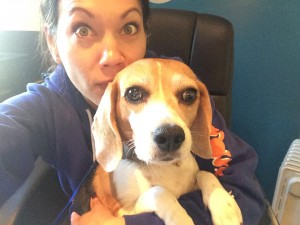In a former life I was a veterinary coordinator. That’s a fancy title for people who answer the phone and schedule appointments at a vet practice (but!) are also called upon to help save lives every now and again.
 proof
proof
For nearly two decades, I counseled people through medical conundrums large and small and had to become competent really fast in giving sound veterinary advice. I’ve worked at general practices, a practice specializing in orthopedics and neurology and for the veterinary program at the fabulous Guide Dogs for the Blind in Marin County.
I’ve had the privilege of shadowing some amazing doctors while they diagnosed and treated, a delicate balancing act between education, experience and good old-fashioned detective work. I’ve seen dogs saved and lost, anguished owners grieve, and angry owners blame. I’ve seen some things.
At WOOF, I’m in charge of monitoring the health of our guests – a responsibility I take very seriously as I’ve seen how quickly a seemingly insignificant problem can go really wrong, really fast.

You could say I’ve been writing this blog in my head for quite a while.
So, what are the Top 10 Tips I would give to owners for going to the vet, you ask? Let me tell you.
But first, the standard disclaimer: I am not a veterinarian. This blog is about sharing some general observations I’ve had as part of the veterinary world and not to be substituted for real medical advice.

1. Try out more than one vet.
Successfully caring for a pet is very dependent on a good relationship between vet and owner. Find a vet who you can communicate with, whose medical approach you understand, and who you like. You might want a small practice that incorporates some acupuncture, or you might prefer a big practice, with in-house diagnostic equipment and 24-hour availability. Figure out what makes you feel safe and who you trust so that each visit isn’t confusing and upsetting. (If you pick the small vet, make sure you have an emergency vet in mind for after hours!)

2. Know your dog and speak up.
Vets need to take a good history of your dog in order to diagnose. They may need to know what they eat, how often they poop, if they are generally hyper or mellow, if they eat socks, etc. You are your dog’s spokesperson! There is nothing more frustrating for a vet than hearing crickets when they ask the owners questions, or owners who go off on unrelated tangents. Remember that symptoms like vomiting and diarrhea could point to so many different illnesses – the details you share with your vet can really make the difference between life and death. Be observant, stay on topic, and give as many relevant details as you can.

3. Stop Googling!
Don’t go into your vet appointment armed with pages of online research and self-diagnoses. Vets have gone through years of study and practice – let them do their jobs. A little information is truly dangerous. If you think you already know what is wrong with your dog, you run the risk of steering your vet in the wrong direction or – worse! – deciding you don’t need to take your dog to the vet at all. (And on this topic, take Yelp reviews with a grain of salt. Even the best vet practice is going to have some loudmouths spewing nonsense online.)

4. Keep and bring records.
If you change vets, move, or go to a different vet for emergencies or specialty treatments, keep copies of any lab work your dog has ever had. Blood work, urinalysis, titers (the tests that determine if booster vaccines are necessary) – each time you get one of these done, (you’ll know because they are expensive!) ask your vet’s receptionist for a copy and keep it in a handy folder. When you can hand your vet previous labs, they can compare your dogs’ values over time and see trends that may help them in diagnosing what may be wrong today.

5. Ask for estimates!
For any vet appointment, you walk in the door already paying an exam fee. They can range from $40 to $90, depending on the practice. (Future readers: these are 2015 prices.)That’s it until the vet takes your dogs’ vitals and history, and then starts suggesting tests, surgeries and treatments. This is where you ask for an estimate. This helps not only determine the cost of your visit, but also illuminates the approaches your vet might take in diagnosing your dog. Any vet worth their salt will not only willingly give an estimate, but gladly do so. This helps them make sure they can collect their fees and protects them against folks who may be ignorant of how much things cost. I’ve had vets work up two or three estimates at a time, pricing all my options at once.
* A special note (and long one, sorry!) about vets and money: I stop listening to people when I hear the words: “All vets care about is money.” This is the battle cry of the ignorant, is unfair and simply not true. Firstly, veterinarians (unless they are specialists) rarely, if ever, make anything close to six figures. Secondly, running a veterinary practice costs money. The overhead for a hospital is staggering and most of the income goes towards staff, leases, insurance and upkeep, not lining the vet’s pocket. And thirdly – and I’m most passionate about this point – vets did not go to school and incur student loans to fund your dog’s health care. That’s your job, as the owner – one you took on when you decided to get a dog. It’s manipulative and insulting to tell a vet they don’t care about dogs because they won’t treat your dog for free. If they did that, they’d be out of business and couldn’t afford to treat their own dogs, many of whom I assure you they’ve probably rescued.
Okay, rant over. Onward!

6. Can this be a tech appointment?
There are many things a technician can do, saving you an exam fee. Things like vaccines, anal gland expression, fecals, nail trims, and even blood draws for pre-ordered tests. Most vet offices will allow this so long as your dog has been seen by the doctor within the past year. So ask for tech appointments for the small stuff, and thank me later when you feel rich and clever.

7. Medications – ask for them!
If you have an ongoing relationship with your vet, and bring your dog in regularly, sometimes your vet will prescribe a medication over the phone. Things like antibiotics for hot spots, pain medications for arthritis, sedatives for the Fourth of July – all can be given without an office visit so long as your dog has had recent blood work and been examined within a year. Make sure to ask about risks and side effects and let your vet decide if a med is reasonable to try before coming into the office. But you can certainly ask!

8. When in doubt, throw in an X-ray
I can’t tell you how many times I’ve seen dogs present with some subtle symptoms – a little dehydrated, minor vomiting, lethargy. Blood work is done and the values seem mostly normal – maybe the white blood cells are a little high, or the dog is a tad anemic. Nothing serious. Can I just say – go ahead and ask for an X-ray. They can be a bit pricey (ask for an estimate!) but sometimes a vet is willing to take one lateral view (that’s the one taken from the side) and it doesn’t cost that much. An X-ray can spot swallowed foreign objects that could obstruct the intestines or a tumor that will eventually burst. Ever since I lost my dog to a splenic tumor that I had no idea was there, I’m a fan of the X-ray. They can’t catch everything, but they can catch some big things.

9. Get the pain meds.
Dogs feel pain just like we do, but they are really good at hiding it. Some say it’s a leftover instinct from the wild because showing pain showed weakness. Whatever the theory, if your dog has had a surgery, an injury or even a particularly nasty hot spot, ask for the pain meds. As long as your dog’s liver and kidney values are normal, there is absolutely no downside to treating their pain, even if you’re not sure it’s bad. The flip side is that your dog will be suffering silently and it’s your job to make sure that doesn’t happen. (This also applies to surgery: make sure there are pain injections on your estimate and that your doctor will be actively controlling your dog’s pain while hospitalized. Sadly, some vets overlook this aspect of treatment and, ironically, make their clients really happy because their surgeries are “cheaper” without the pain injections. Another reason to feel good about paying your vet well!)

10. Lastly, BE NICE.
Vets and their staff are people too. When you are a cooperative client who makes appointments, follows the rules and is pleasant – and doesn’t pull the “all vets care about is money” card when presented with your bill – the staff appreciates you and will be more willing to help you when you really need it. They’ll be more willing to squeeze you in between appointments when you are having an emergency, or to waive the exam fee if the diagnosis was really simple. At the vet’s office, just like in life, it pays to be nice. You are setting the tone for the relationship and you will often be treated as well or as badly as you treat the staff. (And this goes the other way too: if the people at your vet’s office are rude, change vets!)
Going to the vet is really stressful for everyone. You’re worried about your dog, the vet is worried about missing something important and your dog is just plain worried. I hope these tips help in navigating these stressful waters. And please know I am always available to you if you have any questions about your dog’s health.
Here’s to health and happiness,
Vickie Jean
Receptionist
